GLEN ROGERS

This was once a nice coal camp constructed in Wyoming County between 1918 and 1922 by the Raleigh-Wyoming Mining Company. Part of the property can be traced back
to a land grant to James Welsh dated February 11, 1797. An early Glen Rogers engineering report states, "
Much difficulty would naturally be experienced in curing [sic] the title to a property of this magnitude, the tract
at that time being in large part virgin forest and having many squatters and wild cat claims." It is assumed that, typical of that era, these people were
thrown off of the property, or perhaps given jobs building the new coal mine. The Beckley coal seam was prospected, and lab results found the samples to be in the 14,500-15,200 BTU range.
The Sewell seam was also found to be present on the property.
During Glen Rogers's time of construction, the W.M. Ritter Lumber Company had been logging the property, and continued to do so for serveral more years. They hauled the lumber to their
saw mill at their company town of Maben, W.Va.
A few mine and air shafts were sunk to access the 9,100 acre coal lease. When construction commenced the Virginian Railway had not yet built a branch
to the the new mine, so building materials were brought in on an existing narrow gauge logging railroad. Glen Rogers was named after the
founder of the Virginia Railway - Henry H. Rogers - and the first car of coal was shipped in June 1922. A 1922 issue of The Black Diamond magazine states that "the town that was planned to be there
when the last of the 70,000,000 tons of coal has been shipped, is to be a model community and more of a mountain resort than the average idea of a mining camp." The high water mark of production was 955,000 tons in 1940, and for a time
it was the biggest coal producer on the Virginian Railway. The mine closed and the company went bankrupt in 1960. I found it
reduced from its former grandeur to the state you see in these photos.
From a July 10, 1965 United Press International article - NEARLY A GHOST TOWN AND SOLD LIKE OLD CAR by N.S. Ludington
In 1920 Engineer Carl Scholz overcame tremendous obstacles to sink a 700-foot shaft down to a rich seam of smokeless coal under this town. The new mine was swampy. Water poured into the shaft as it was dug.
Finally, a small mine was worked nearby to provide coal to fuel pumps which emptied the shaft. Then Mr. Scholz built the town, the home of 2500 miners and their families. He called it, in 1933, "one of the most progressive
mining communities that has ever been my privilege to be connected with." ...
Now Glen Rogers is nearly a ghost town - and it's been sold like a used car. In May, with the mine closed for five years, the town was sold by the bankrupt Wyoming Pocahontas Coal & Coke Co. to the Youghiogheny and Ohio Coal Co.
Nature is reclaiming its own here. I drove to Glen Rogers, through the angular, forested mountains of southern West Virginia, to see a town dying. My first impression was the melancholy quiet. The only life visible was two old men
chatting in the shade of the abandoned company store and office building. Behind them the screen doors hung lopsided from one hinge. Most of the houses are deserted and the windows gape jaggedly where they were smashed. Weeds and
vines grow everywhere and twine in the rotting carcasses of abandoned trucks and cars. The town has a central square with three solid brick buildings - the store building, a "recreational hall" housing a deserted movie theatre,
barber shop and pool hall; and a "clubhouse" where unmarried miners once boarded. I looked through a grimy window into the old company office. Dusty papers littered the floor and the big safe - which one held payrolls for more than 1000 miners - gaped open.
Next to the square is the minehead. The tipple, rails, power plant and machine shop have all been gutted for scrap. The power plant's concrete smokestack towers coldly over the rusted remains like a monument to the once-proud
mine - largest on the Virginian Railway - which had a peak production of 8000 tons a day.
The first person I met in Glen Rogers was Postmaster Hayden Wolfe. Outside the post office in the recreation building the American flag hung over an old sign saying "beauty parlor." Mr. Wolfe worked in the mine for 25 years
until he was forced to retire in 1954 by a miner's nemisis - silicosis [Black Lung]. "I took a census yesterday," he told me, "and came up with 275 people. Last year it was a real ghost town when only about 75 were left." Mr.
Wolfe explained that since then some people had taken advantage of the new company's offer to sell houses at low prices and had come to Glen Rogers. He said they were mostly retired or on relief. "It was a real pretty
community," he said. "Even though they didn't own it, people took care of their property. I swear we had the best hearted people you ever saw. Coal miners are strange. No matter how much money they make they are always short.
But if someone got burnt out or injured we never had any trouble passing around and raising seven, eight hundred dollars for them. I'll tell you a strange thing. People who left when the mine closed always come back, just for
visits, maybe from New Jersey or Washington, but they come back. There is something about the town."
To Mr. Wolfe and to others like Mrs. C.C. Cottrell, Glen Rogers had a personality. Mrs. Cottrell's husband is a dentist and his office is the only enterprise in town besides Mr. Wolfe's post office. Her family lived in the
only log cabin in the valley when Mr. Schloz arrived to sink the mine. Her roots are deep here. Dr. Cottrell said his patients almost all come from outside the town. He stays in Glen Rogers because of his wife's family and
because he loves the town. "I hated to see it die," he said. "No one knew anything until the day the mine closed. Then most people had to sell what little furniture they had just to raise money to get out of town." Dr. Cottrell and a few
other citizens tried to raise money to buy the town site from the company in 1960 after the closing, in hopes of enticing some new industry in. But the company turned down their offer. Mr. Wolfe said the company also refused
to lease the old pool hall as a small store and start a gas station outside. "We couldn't form any town government or do anything for ourselves since the company made all the decisions," he said. [So much for the stereotype of
helpless, dependent, fatalistic Appalachians.]
The town government of Glen Rogers is all wrapped up in the burly figure of Walter Brooks, who looks out for the interests of the town's new owners. Mr. Brooks, a former mine superintendent, was appointed court trustee
when the mining company went into bankruptcy in 1960, and was hired to watch over Glen Rogers by the Youghiogheny and Ohio Coal Co. when it bought the town. I asked Mr. Brooks why the mine closed. "It shouldn't have. There is
no finer coal in the world and there is plenty of it down there." [This coal was probably later mined by Maple Meadows.] "The company just didn't keep up with the times. They used second-hand equipment and there were too
many breakdowns and productivity was too low. They started to put in new equipment at the end but it was too late." Mr. Brooks is pessimistic about any future for Glen Rogers. He said the present owners bought the town and
mineral rights to 29,000 acres around as "a reserve." "But there won't be anything happening here. Not in my lifetime anyway. For one thing the mine is flooded. There's water up to within 50 feet of the top of the shaft."
I took a last tour around before driving out of Glen Rogers. All over, as if nature were trying to cover up the decay, grew thick patches of vivid wild pink roses. A few raggedy children played by the tracks which had
carried gondola cars loaded with millions of tons of Glen Rogers coal. Otherwise the town was quiet, a ghost passively accepting the return to wilderness.
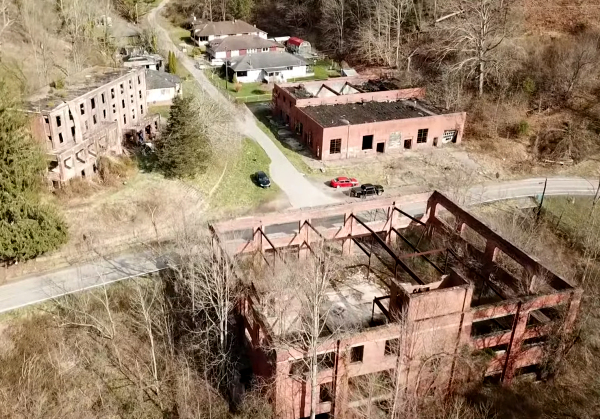
Image courtesy of the Webster Highlanders
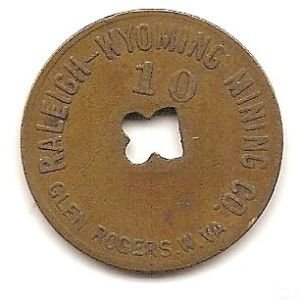
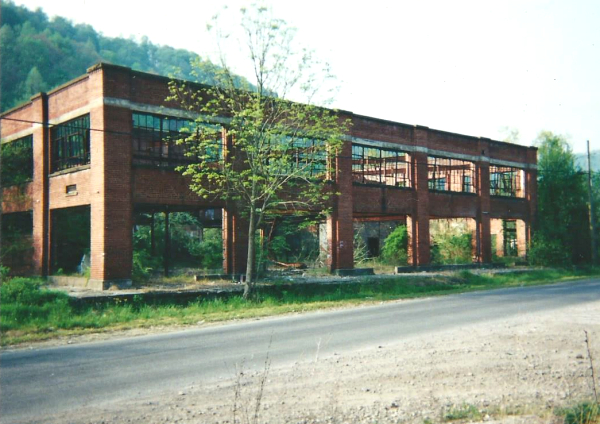
May 2001 image by author
The shell of the company store.
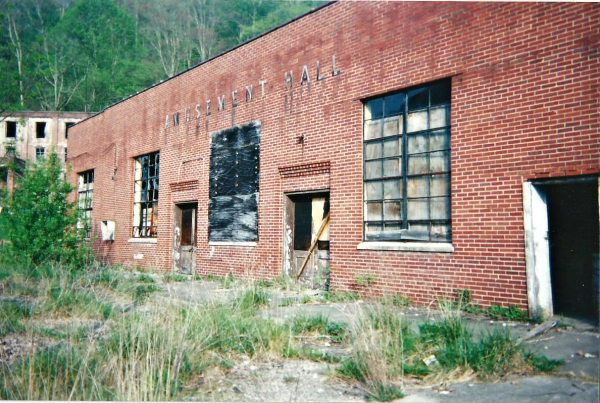
May 2001 image by author
The Amusement Hall built by the coal company for the miners in the 1940's. This structure also
contained a theatre, restaurant, barber shop, and "beauty parlor."
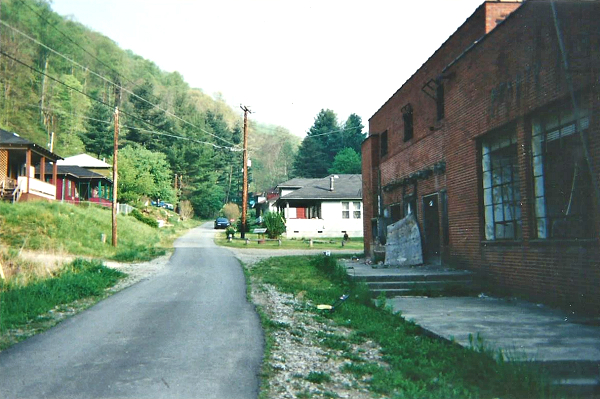
May 2001 image by author
Section of the camp behind the Amusement Hall.
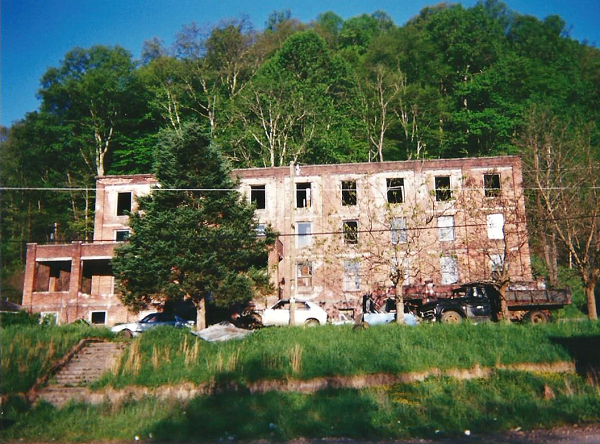
May 2001 image by author
Once a hotel, then a boarding house, this landmark was allowed to fall into ruin.
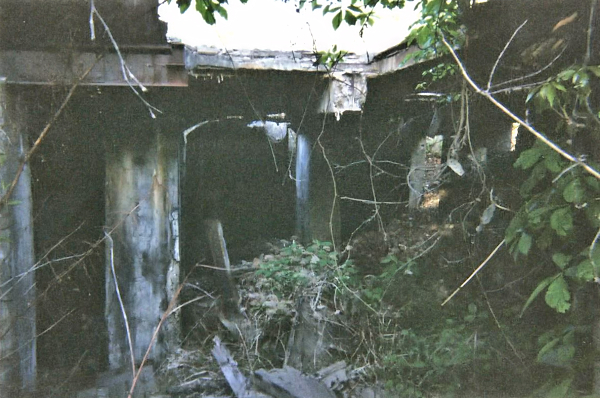
May 2001 image by author
Ruins of the coal tipple site.
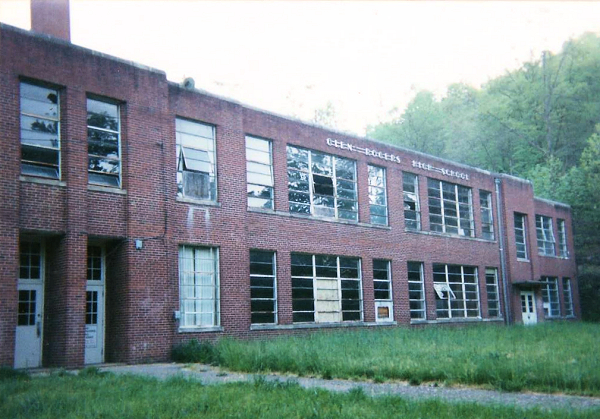
May 2001 image by author
Glen Rogers High School sits empty. It was built in 1951 to replace an earlier structure. The school was closed in 1992 when enrollment dropped under 200 students.
The school has since been demolished.
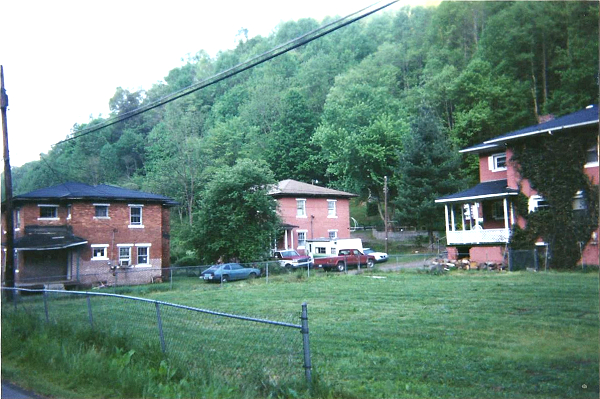
May 2001 image by author
The coal company probably built these two-family brick homes with indoor plumbing for the mine bosses. The brick was made on site. The other
miners homes, however, were of the wood frame type. Unlike many other coal camp houses, these had running water and indoor bathrooms.
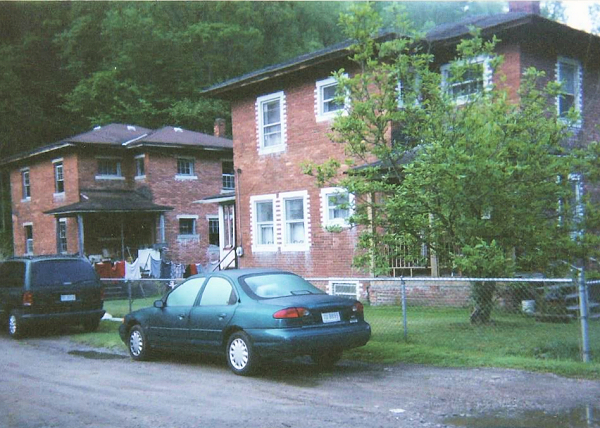
May 2001 image by author
A closer look at the brick coal company houses.
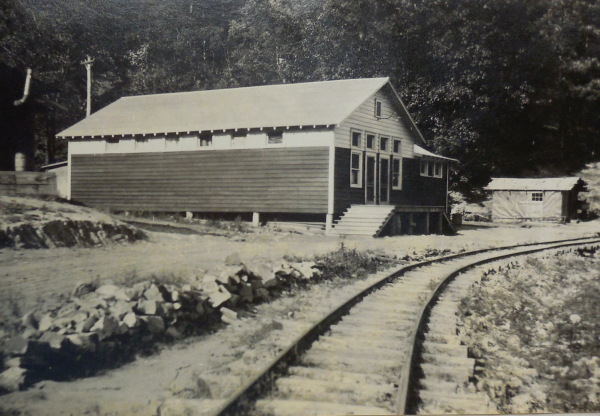
1920s Ernest M. Merrill Engineering photo
At first this temporary company store was built until the more grand brick company store could be constructed.
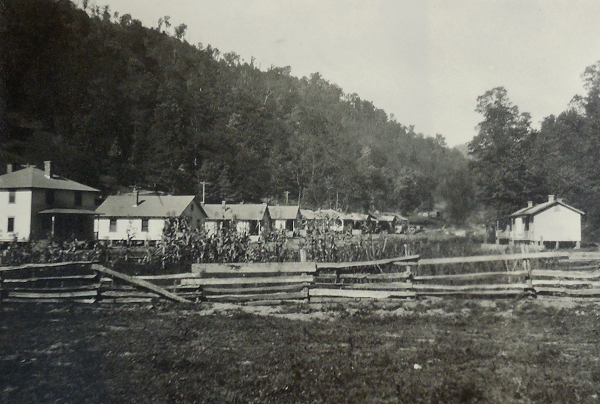
1920s Ernest M. Merrill Engineering photo
The Glen Rogers coal camp when it was new. I can't help wondering if the split rail fence was left over from the pre-industrial mountaineer homestead that existed on the site.
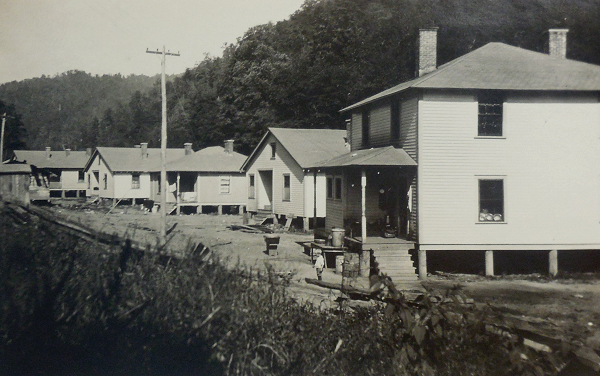
1920s Ernest M. Merrill Engineering photo
This is one of the residential sections of Glen Rogers just as construction was completed. Note the variety of housing styles that were used, in contrast to the more
monotonous style of coal camps that had been previously built. The structure on the right was a boarding house.
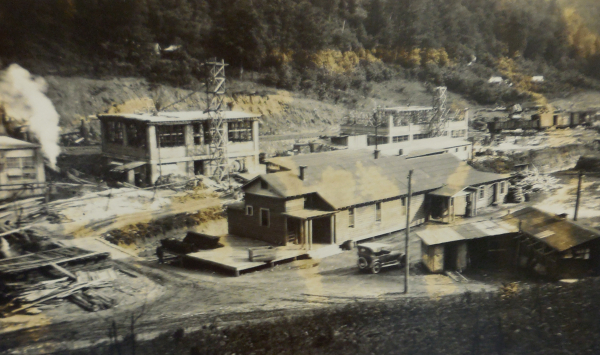
1920s Ernest M. Merrill Engineering photo
Visible in this image are the lamp house, bath house, mine foreman's office, machine shop, and temporary office - all in various stages of construction.
The building in the middle was the temporary community building.
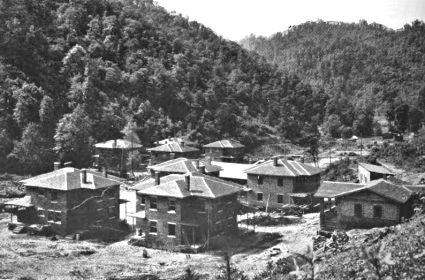
Circa 1922 Black Diamond magazine image via Google Books
The brick company houses from above, shown when they were being
constructed.
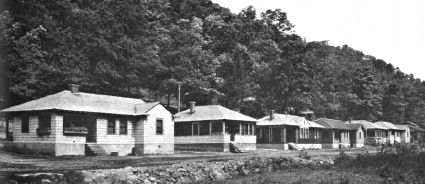
Circa 1922 Black Diamond magazine image via Google Books
Other coal company homes at Glen Rogers when they
were new. These were good quality company houses, and Glen Rogers was certainly a "model" coal camp.
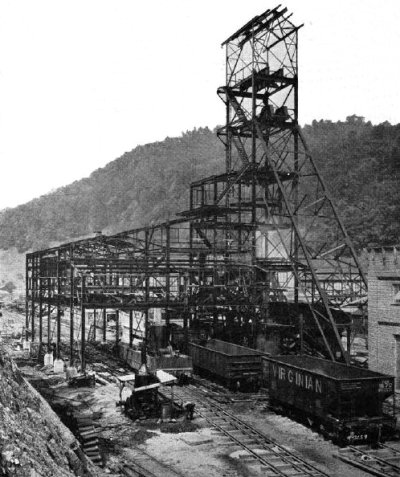
Circa 1922 Black Diamond magazine image via Google Books
Photo shows the Glen Rogers tipple under construction. This
was one of the few vertical shaft coal mines in the Winding Gulf Field, and the shaft was approximatley 650' deep.
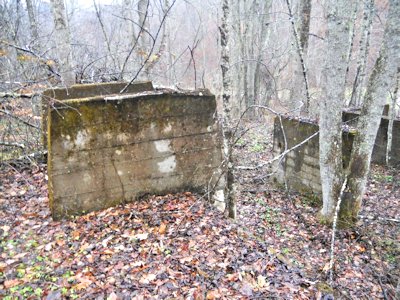
Dec. 2012 WV AML Program image
Ruins of the Glen Rogers coal mine in the woods.
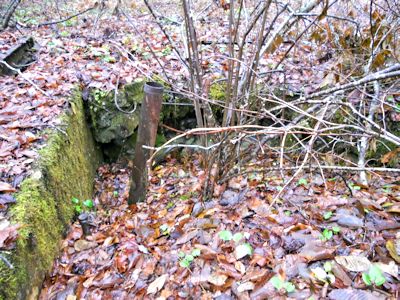
Dec. 2012 WV AML Program image
Remains of one of the vertical mine shafts.
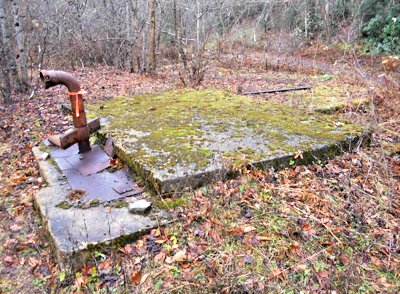
Dec. 2012 WV AML Program image
Vented cap over another of the mine shafts.
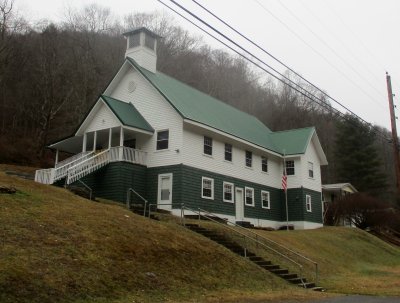
Feb. 2021 image by author
A well-maintained church.
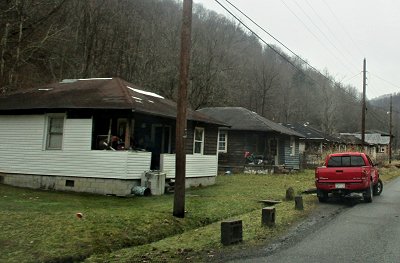
Feb. 2021 image by author
Some of the surviving coal company houses.
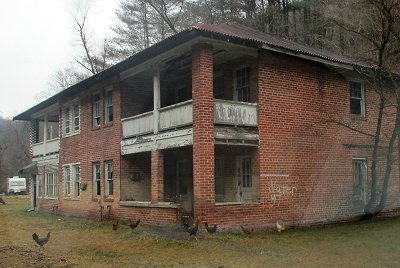
Feb. 2021 image by author
This old company-built apartment building now houses chickens.
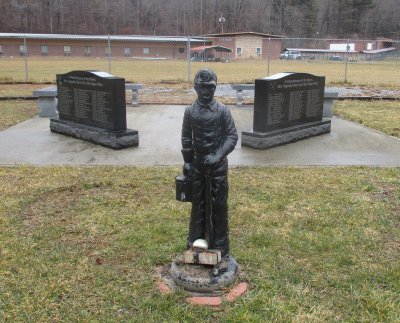
Feb. 2021 image by author
Someone has constructed this nice memorial to all of the miners who perished in the Glen Rogers coal mine.
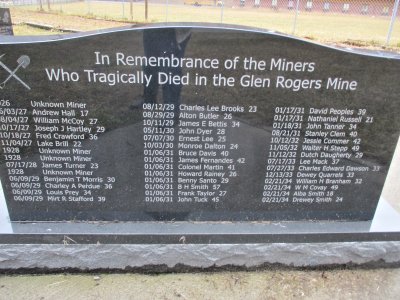
Feb. 2021 image by author
Names on one of the headstones.
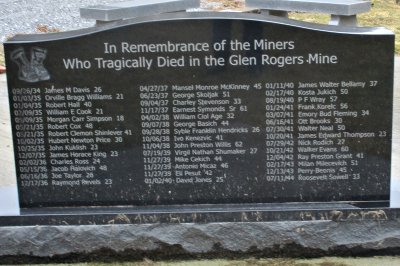
Feb. 2021 image by author
The other headstone.
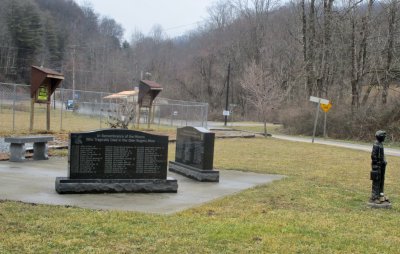
Feb. 2021 image by author

May 2001 image by author